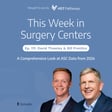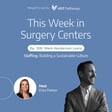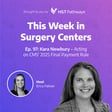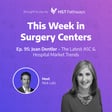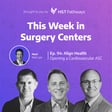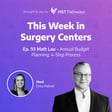Introduction and Format Overview
00:00:01
Speaker
Welcome to This Week in Surgery Centers. If you're in the ASC industry, then you're in the right place. Every week, we'll start the episode off by sharing an interesting conversation we had with our featured guests, and then we'll close the episode by recapping the latest news impacting surgery centers. We're excited to share with you what we have, so let's get started and see what the industry's been up to.
Release of HST 2024 Industry Report
00:00:27
Speaker
Hi everyone, here's what you can expect on today's episode. On September 25th, HST released the 2024 edition of our annual State of the Industry report. If you're not familiar with it, we first introduced to the report last year and it covers best practices, key process steps, and key performance indicators for every stage of the patient journey, as well as for nearly every recurring administrative duty.
00:00:53
Speaker
What I think makes the report most valuable is that we use our own product and client data to provide free benchmarking that represents 590 ASCs across 47 states.
Webinar Insights and Patient Journey
00:01:05
Speaker
And this year's report features over 130 KPI ideas to track, 50 chapters, 36 charts, which does include 12 year over year comparisons, and then five emerging trends everyone should be keeping an eye on.
00:01:18
Speaker
The data was put together by myself and our senior director of data science and insights, Will Evans. And we actually hosted a webinar together to discuss those five emerging trends and 13 of the key benchmarks that we tracked. So it was really exciting to see so many of you register and attend and the questions we've received during the webinar made for an even more engaging conversation.
00:01:42
Speaker
So this week's episode is a recording of that live webinar we did. If you are listening on a podcast, I would recommend switching over to YouTube just so you can follow along and look at the graphs and data that we're referring to. Just might make it more interesting, but completely up to you. I'll also include a link in the notes where you can request a printed copy of the report to be mailed to you. I know some people just prefer that hard copy versus a digital copy. So please take advantage of that if you'd like to. It's totally free.
00:02:12
Speaker
And as always, I'll include all the links I just mentioned to the report, to the YouTube video, to the print requests in the episode notes, so you can easily access all of those. Hope everyone enjoys the episode and here's what's going on this week in Surgery Centers.
00:02:31
Speaker
Thank you all so much for joining us this afternoon. I am Erica Palmer from HST Pathways and I'll be moderating the webinar today. When writing this report, we really tried to look at the entire patient journey from the moment it's decided that a patient needs surgery to the moment that they're discharged and you know, what happens at your surgery center after the patient is
Data Analysis and Proactive Operations
00:02:53
Speaker
discharged. So we laid that out chronologically.
00:02:55
Speaker
And then we also looked at all of the ah recurring administrative duties that surgery center leaders have and broke those out by frequency. So what should you be doing on a daily or weekly basis, a monthly quarterly basis, annual basis, all of that. We then pulled client data in areas where we could to share facts and figures that support that patient journey and those admin duties.
00:03:19
Speaker
And that came out to 50 chapters, 130 plus KPI ideas. So if you ever get in a pickle with some QAPI studies, you're not sure where to turn these KPIs in here, it could be a great resource for you. And then as I mentioned, using our data, we were able to pull out 36 charts, 12 of which were year over year comparisons and a few trends we'll walk through as well. So.
Challenges Facing ASCs
00:03:43
Speaker
As Will has shared with me, we pulled data from clients who have given us permission to do, and then we also admit any ah extreme outliers to this year that looked like 590 surgery centers from 47 states. And we're looking at around 3 million different cases. And here's some, just breaking it out further centers by OR. So you could see most of our clients have three or four ORs.
00:04:11
Speaker
And then we also looked at the ownership breakout as well, which could have an impact.
00:04:21
Speaker
Okay. So why, why does this matter? Why does, why are we doing this? Why are we putting three months of work into a report to share with all of you? I think. as most of you are experiencing, the world has changed for ASCs, right? So what worked even 10, even five years ago is no longer working. You're all dealing with stagnating reimbursements, increasing competition and consolidation. I mentioned the podcast earlier. I do a news segment sometimes and I feel every week I could share a story about a different acquisition and a health system, a new JV, whatever it might be.
00:04:58
Speaker
You're dealing with higher acuity cases, of course, staffing shortages and just the rising cost of everything. The margins are getting smaller as time is going on. You'll hear me use this phrase throughout the day. Proactive operations is what we're focusing on by sharing this data with you. So we really want all of you to focus on that data-driven proactive approach where we're not making decisions based off of hunches or what our gut is telling us. While those are extremely important,
00:05:28
Speaker
especially for with your most experienced staff, focusing on the data will allow you to shift from that reactive mindset to that proactive mindset.
Financial Impact and Incremental Changes
00:05:37
Speaker
And data is really at the core of that. Again, I'll share these slides out so I won't spend too much time analyzing this with all of you, but I do recommend taking a closer look. It really just shows how these incremental changes will push you out of like the average ASC market and into that top quartile or ideally that 90th percentile. And in these two examples we have here, when it comes to case profitability and an OR utilization, you can see the financial impact even those incremental changes can have.
00:06:09
Speaker
and those outliers that are in that 90th percentile, they're looking at their OR utilization and case mix, they're analyzing case profitability, automation, you that will definitely be a theme throughout all of this, kind of moving away from those manual processes and getting into that the automation side of things, benchmarking everything as much as you can, forecasting, and it of course optimizing the physician experience.
00:06:34
Speaker
And once you really lean into this, it will change everything for your staff from administration. So again, moving from that reactive work that redundant low value tasks to those high value proactive tasks.
00:06:47
Speaker
Your clinical team will see a change. Your physicians will move from just putting out fires to being able to focus on the patients and strategize about driving profitability. If you do have a management company or you work at a management company, this is going to allow you to be proactive with your insights, not have to wait months just to look back at previous quarters. You can see your whole portfolio is benchmarking data. And then of course, ultimately your financial outcomes will all benefit from this as well.
00:07:17
Speaker
So I hope all of that has convinced you why taking that data-driven approach is so important and why we put so much time and effort into all of this for all of
Trends in 2024 Report
00:07:25
Speaker
you. All right. So let's jump into the trends now that we saw from the 2024 report.
00:07:32
Speaker
Well, hand it over for to you for a second. Can you please explain how we pulled some of these numbers? Sure. So the first thing whenever I like to talk about how we've calculated numbers, one of the really important pieces is the timeframes that we're pulling data for.
00:07:49
Speaker
So for 2024, we measured all of this data for dates of service starting January 1st through the end of Q2, so June 30th. And then for 2023, and this is true for all year-over-year metrics in the report where you see 2023 mentioned, we pulled it for the full ah year. So we started January 1st all the way through December 31st. So when anytime you see 2023 metrics here,
00:08:14
Speaker
It's full year anytime you see 2024. It's the first two quarters of this of 2024.
Revenue and Efficiency in OR Usage
00:08:21
Speaker
Now, specifically relating to the metrics on the screen, averaged OR duration in minutes, that's a pretty straightforward calculation. All we're doing here is we're averaging the OR duration um for all of the cardiology procedures. Similarly, average net revenue per case, that's just the sum of contract fees divided by the unique count of cases.
00:08:46
Speaker
And then for average revenue per OR and oh our minute, we're just dividing ah those two numbers through together. So for 2023, 5,014 divided by 48. And that gives you the average revenue per OR minute. perfect Perfect. Thank you, Will.
00:09:05
Speaker
So you'll see a trend here as well with the data that we'll put together. We also tried to put it together some influencing factors to explain why we might be seeing these numbers. It is a little limiting. We have two years worth of data, right? So while we are seeing trends,
00:09:21
Speaker
It'll be even more interesting next year when we can see that third year of data. However, in this case for cardio specifically, we wanted to pull out a few numbers here just because it's such a hot topic right now. And as you'll notice, as we go through, the revenue per case is so high compared to other specialties. It's actually just the second behind, second highest behind ortho. Despite the lower net revenue per case in this situation from last year to this year,
00:09:49
Speaker
Because we are getting more efficient in the OR and the OR duration has decreased, that revenue per OR minute has increased by 27% from last year into this year, which is really exciting to see. And I think it's just going to only increase people's interest in cardio in the outpatient space.
Payer Reimbursement and Case Volume Shifts
00:10:09
Speaker
So some influencing factors, just more experience in the ah OR, right? We're going to start moving at a faster pace, reducing overall procedure time, but always maintaining that safety, the safety and outcomes up for patients. And we're also bringing more experienced staff and surgeons who have these refined, refined workflows and techniques that, that maybe they learned in a different setting that they're we're now bringing to the outpatient space.
00:10:34
Speaker
Technology is of course playing a role in that OR, right? We're getting better tools, better imaging systems, these faster, less invasive procedures. Those could, that could definitely be driving down the OR duration. And then on the payer side though, this is where I tried to spend some time looking at, okay, why is the net revenue per case decreasing from last year to this year?
00:10:57
Speaker
And after speaking with a few people, it seems like the theory is that the reimbursement rates are not reflecting yet of the benefits of bringing cardio to the outpatient space. So that could explain the decrease there.
Orthopedics and Revenue Trends
00:11:12
Speaker
And then but just a shift in case volume too. So if there is an increase in these lower complexity cases and we're performing those at a higher volume, then that might be driving down the average revenue per case as well.
00:11:28
Speaker
All right, let's talk about ortho. How did you drive these numbers? So again, this is one where I'll just mention the 2023 versus 2024 timeframe comparison. And here relating to the average net revenue per case, it's just a pretty straightforward calculation. You're just ah summing up the contract fee by specialty per case, and then dividing through the unique the unique count of cases.
00:11:55
Speaker
And um similarly to last year when we went through and mapped each of the cases onto specialties, um we did that mapping based on the primary CPT code associated with that case. Perfect.
00:12:12
Speaker
So as we saw from 2023 to 2024, ortho still has the highest net revenue per case, and we even saw an increase in what that net revenue is. um So of course, influencing factors, there's just a strong demand for these ortho procedures in an outpatient facility. Agent population, sports injuries, and just more patients seeking that outpatient experience.
00:12:37
Speaker
I read this really interesting article to this is speculation right now, but it does make sense. All of these increase in medications like Ozempic, all the semiglutides, the GLP ones, they're a large portion of the population is losing weight faster than they have been able to before.
00:12:55
Speaker
which means with that comes more activity. And it's possible that with that increase in activity when they previously did not have as much, it's just leading to all these injuries, which is very interesting to think about. And then don't get me started on pickleball. That's going to have a huge impact on orthopedic procedures, ACLs, hips, shoulders, all of that. so Those are two small influencing factors, but it just will never, I can't imagine a world where we start to see a decrease in ortho procedures in an ASC setting.
ASC Preference Over Hospitals
00:13:28
Speaker
And then with the higher reimbursement rates, we're just continue, payers are just continuing to reward ASCs compared to traditional hospital setting.
00:13:40
Speaker
All right. Let's talk claim denial rates. Claim denial rates this is again a pretty straightforward calculation where we're just taking a unique count of the claims that were where they received a denial and then ah dividing that by the entire population of claims submitted whether they received and and a denial or not and one of the things that I do want to call out especially in the year-over-year metrics is that we're going to start to see, ah we' we'll start to establish trends over
Claim Denials and Efficient Processes
00:14:11
Speaker
time. And within those trends, you're going to see normal fluctuations up and down. And so while I, while it's encouraging to see a 4% decline in claim denial rates year over year, a certain amount of that I think is just going to be related to noise within the data, just based on essentially what happens as you start to incorporate more ASCs into your dataset.
00:14:35
Speaker
sure Yeah, that's a great call. Even with that, it was really exciting to see the denial rates go down from 8% to 4% in 2024. That could be a real major success for some surgery centers in terms of cash flow and just reducing that kind of rework for the billing teams that you have.
00:14:54
Speaker
um Obviously, lower claim denial rates means faster payments, less revenue tied up in AR, and more time for your staff to focus on other important tasks. And getting your claim submitted successfully for the first time is a huge indicator of the success of your RCM process. It means you likely received the proper pre-off and insurance verification, and there wasn't any missing or incorrect data. You submitted it on time, all the little nuances.
00:15:23
Speaker
really excited to see the improvement on this end. And I do have a note here about i i my assumption is that the majority of people
Growth in Smaller ASCs
00:15:32
Speaker
in this database are not using AI for coding yet. However, I think it's just something we don't want to forget about that.
00:15:41
Speaker
using AI in your surgery center can feel a little scary and a little overwhelming, but with this side of the house that isn't related to patient safety, patient outcomes, it's a really good idea. And there's already some great companies out there that are helping on the AI front when it comes to the claim process.
00:16:01
Speaker
Okay, let's talk about case volume, Will. All right, so this is one instance where we didn't follow the the blanket rule of all of 2024 versus first quarter and second quarter of 2023. When we went about calculating the change in case volume here, we did take the snapshot of Q1 and Q2 data for 2023 and 2024.
00:16:24
Speaker
And the other thing I do want to also make sure I mention is that this is for the same population of centers. So it's not like we took the data from last year's report and compared it to this year's. We took ah continue a set of customer data and when we did the comparison.
00:16:42
Speaker
Now, as far as the math on this one, it's pretty straightforward. All we did was we counted the unique visits at centers in Q1 Q2 of this year and divided it by the ah unique visits for Q1 and Q2 of 2024 and divided that through. And that was how we calculated the case volume change year over year.
00:17:00
Speaker
I do want to also mention on this one, I think this one last year, larger centers had a higher growth in um case volume year over year. And this year we started to see that shift a little bit back. I think this is another metric where you're going to see a fair amount of fluctuation over time, just purely based on sample size and the ASCs that we include in our population. Sure. Yeah, this one was super interesting to me and this is one I think this one along with case cancellation rates is one of my favorite, or one I just find most interesting every year. If we take this data at face value, the smaller ASCs are likely just more nimble, more adaptable. They can quickly pivot. If they are monitoring data and trends, they can start, it's easier for them to start heading and in one direction versus the larger facilities. The smaller facilities just have fewer staff.
00:17:55
Speaker
supply needs, those just lower overhead costs as a whole. Usually with smaller facilities too, there's just a shorter decision making process. So you have these streamline management structures that make it easier to make the tough decisions, whereas the larger facilities most likely need a lot of people to buy in before you can pivot. If you are experiencing a trend or you do, ah i if you can't identify something that you know needs to be fixed, it could just take longer to to take action on it versus smaller facilities.
00:18:24
Speaker
And again, if if we take this data at face value, those larger facilities are struggling to scale, right? Obviously you are going to hit a peak, these 15 plus ORs, you can only in theory grow so much. Obviously we would prefer to see maintenance versus loss of case volume, but it's likely these larger facilities are just harder hit with the staffing shortages, the increase overhead and some of those administrative burdens. So not all of that is true for every facility, but just could be some influencing factors.
00:18:56
Speaker
All right, and then our last trend here, let's talk about payments.
Reimbursement Categories and Payment Plans
00:19:00
Speaker
So for total reimbursement, what we did is we essentially compared payments versus the contract fee. So when you look at the categorization overpayment total, near total and partial, essentially if a senator received more payments than the sum of the contract fee for the CPT codes assigned to a case,
00:19:22
Speaker
that that was categorized as an overpayment. If the amounts matched exactly, that was categorized as total. And then this year we split out um what we termed as near total, which was essentially if the underpayment was $5 or less, we assumed that the center's probably not going to spend a lot of time chasing down that, that extra $5. And we separated that into its own category. This is one where we would be interested in your feedback. If you have a similar metric or you use a different threshold, please let us know. And then for all the other underpayments, we just bucketed that as partial.
00:20:03
Speaker
Perfect. Thank you. Yeah, this one was also really interesting. And if we think about some influencing factors, at least on the partial payment side, to me, it's directly related to those high deductible health plans, right? So patients are just becoming more and more responsible for a larger portion of their healthcare costs upfront before insurance kicks in. So that could be a reason why we're seeing more partial payments.
00:20:27
Speaker
And then a lot of those payment patients just can't pay that pay all of it upfront, even if they do plan to, to hopefully pay eventually and payment plans. And because of all that payment plans are becoming more common, which is a good thing. Um, but it just means your revenue cycle is elongated.
00:20:45
Speaker
And then I was speaking with the owner of one of our pretty popular RCM company. And she was telling me that she's consistent, consistently seeing payers, just not paying it full with not good reason there. They just think that they could get away with it. So they're just lowering their reimbursement rates, thinking some of their, some of the surgery centers might not have time to catch it. Hopefully that is not true, but I fear it likely is.
00:21:10
Speaker
with high deductible plans and payers not but reimbursing in full, both of those things could be contributing factors here. but We did have one question about denials. I'm just going to go back to that slide quick.
Denial Rates and Payer Data Integration
00:21:22
Speaker
Someone shared, if denials for 2023 was all 12 months, but denials for 2024 was Q1, Q2, could the difference be related to seasonality?
00:21:34
Speaker
We often see more Medicare government in the first part of the year and more commercial towards the end, and commercials tend to always be more prone to deny than government. It definitely could be we did this was when we did some additional analysis on where we plotted it out by quarters and months and we definitely did see fluctuations that occurred throughout the year. i'll definitely when we rerun these next year i'll be interested to see if that 2024 number does burn up to closer to 8% and then just.
00:22:06
Speaker
not to give away all of our roadmap for where we we were where we want to go on the state of the industry report. But pulling in payer data is something that Eric and I have talked about over the past two years. And the main challenge has always been in normalizing that data. But this is one of the metrics that we always mention that would be great to be able to break down denial rates by payer. But it's a great call out that we definitely want to dig further into.
00:22:33
Speaker
Yeah, that's super interesting. Great question, thank you. Okay, so those were, again, some of the trends that we've been seeing. So we'll take a similar approach to just going through some of the additional data that we saw here. So Will, how'd you get to this data?
OR Block Time and Utilization
00:22:49
Speaker
So OR block time utilization, the numerator, to be honest, is the easy part. It's literally just the sum of blocks used during a minute. And then we divide that through into the time that was blocked in an OR. Yeah, then we divide that through into the time that was blocked during the OR. The art is in how we match up that data. And so within HST, there's no, when you schedule cases and appointments, there's nothing that uniquely ties it to a block specifically in the back end. And so the way that we match these up is we identified cases where the start and stop times occurred during the blocks that were scheduled. And so essentially we made sure that the start and top the start the start and stop times were within those blocks.
00:23:37
Speaker
and that the physicians performing those cases were also assigned to the blocks or they were a part of a group of physicians that had reserved that block. One thing I do want to call out is that ah we got a question last year around what happens if physicians are using flip rooms or they're flipping back and forth between rooms. And those would be accounted for in here as long as the physician is assigned to both of the blocks.
00:24:02
Speaker
for those rooms, we do know that some customers, well when they do flip rooms, they don't assign the physician to that second room in HST, but they still block the time, it just doesn't have a physician associated with it. So in the instance where there's no physician assigned to a block, that doesn't end up getting tied to the denominator in this data set, nor would the the cases actually assigned to that block ah be pulled into the numerator.
00:24:33
Speaker
Gotcha. We did have one question come in. Did you include into out of room and turnover times as the numerator? Yes, we did. So and and basically the yeah the turnover time between cases as long as that this goes into the more fun of how you actually calculate the block times. But as long as the appointments occurred consecutively within a block, we did include that time.
00:25:02
Speaker
And so if appointments finished early and there was time left over at the end of the block, but then another case occurred after that empty room time doesn't get, didn't get included in the numerator. Okay. Gotcha. That makes sense.
00:25:17
Speaker
And again, if anyone has any questions, ah wants more detail, you can always follow up with us too. But just some quick tips to improve some of your OR utilization. So broadcasting your open OR availability to your physician offices and schedulers is super important. It needs to be accessible to them at all times. um But you should also set up automated reminders and um emails just to update them to let you know when you do have a cancellation or an open time. um Obviously setting goals is uh, important, uh, we actually have a really great podcast episode all about improving our block time utilization with Amy Ishmael, who was a former scheduler. Um, but she has great tips in there in terms of having that 72 hour release policy, making, having that the, all of your physicians signed, whatever policy you do come up with.
Pre-Authorization and Technology Integration
00:26:07
Speaker
And then she had offered some great tips in terms of, um, public praise as well, having a white board of, of where physicians are at and sharing at your board meetings as well.
00:26:18
Speaker
ah Okay. We do have some questions coming in, but I see one is specific to an HST product, um which Chris and I will follow up with you on that. And then Andrew wanted some specific details on the formula with the numerators and denominators. So well, maybe we could put that together and send that out as well. Yeah. Okay. Let's switch to pre-auth rates.
00:26:45
Speaker
Uh, so for preauthorization, this, the simplest way to describe this is that we calculate or we just count the unique cases where preauthorization was completed or not required. And then we divide that through by just the total count of cases. Perfect. Thank you.
00:27:08
Speaker
So i I'll leave you guys with this slide really quick because we do have part two of this which I think is interesting or a little more interesting. So this one is saying 46% of cases completed pre-auth. Now this version of it I find to be a little bit more insightful where only 24% of cases completed pre-auth when it was required. So this is a stat I'm going to, again, just be super interested to see if it keeps climbing next year. You can see it did improve from 2023 a little bit, but obviously this is a good indicator of maybe some of inefficiencies you might be seeing on the front end that can lead to delays in care, denied claims, and just have that direct impact on revenue and patient satisfaction as well.
00:27:52
Speaker
So a trend with all of this is that while our data is extremely helpful, you really should be tracking all of this on your end. So you can see what your baseline is and and where you need to ah improve improve communication between the front office and staff. You can hold quick daily huddles, make sure everything, every case that needs pre-auth has it. um Technology, right? It's a little under you underutilized in this sense, but you should have technology that integrates seamlessly with clearing houses and payers.
00:28:22
Speaker
so that it's automatically doing those pre-auth checks and tracking when pre-auth is needed and also flagging for you when pre-auth is needed and not properly received. And then just adjusting some of your documentation practices and training your staff. So send your staff to those state and national conferences. Most of them always have that billing track that they could attend and also allows them to network and learn as well.
00:28:47
Speaker
And Eric I just on the this slide for the calculation is the same calculation as the prior slide. All we're doing is we're removing on the back end of HST there's a ah On pre authorization. It'll say NR for not required. So all we did was we removed all of the ah cases that had an NR from the calculation and then we did the same math.
00:29:15
Speaker
All right, let's talk insurance verifications. This one's a pretty straightforward calculation. All we did was anytime insurance verification is completed in HST, a case gets ah a Y for a yes. So all we did was we did a unique count of all the yeses and we divided it by the total population of cases for the timeframe. Perfect. Thanks.
00:29:38
Speaker
So if we're looking at this, we're seeing that 22% of cases are at risk for delayed payments, denials, and of course patient surprises too, which can obviously lead to high dissatisfaction. So again, we're always going to start with identifying those trends. We're looking at procedures, payers, time periods, for your surgery center are specifically, what are the trends that you're seeing that you can try to identify and and get ahead of. Working on that communication again, so establishing that workflow,
00:30:07
Speaker
very similar tips to us to last slide. Using that technology, you really need to have technology that's integrated with those clearing houses. It's just gonna automate everything for you, reduce manual errors, um and most importantly, flag potential issues before the procedure is scheduled. And we really just wanted to try to get this number up as high as we possibly can.
Case Cancellations and Control
00:30:32
Speaker
I am reading questions as they're coming in as well. Let's do case cancellation rates. Case cancellation is a pretty straightforward calculation, but it's just the distinct count of canceled cases divided by the total count of ah cases, whether they were completed or canceled. Thanks.
00:30:52
Speaker
Just a quick note, we are getting some questions about how to specifically do this within HSC products. Just for the sake of time, I see them all, I'm saving them all. And I will make sure that you are all followed up with after this, all of our clients are followed up with so that you understand what you need to pull to get to these numbers yourself. So I'm not ignoring you guys. I just want to just be cognizant of the time and make sure we can properly answer your questions.
00:31:18
Speaker
But we do, we did have one verification question come in, though, so let me jump back there. Our provider errors accounted for with the verification, an example being that a patient is scheduled for a procedure that is authorized but deviates slightly from that procedure by billing with different CPT codes.
00:31:38
Speaker
I would have to go dig into the data to check. Essentially, as long as the case still remained flagged as yes, insurance verification was complete, that would be still counted as a yes, but I'll have to go double check to see, to dig into the details a little bit. That's a good question. Okay. That question did come in anonymously. Whoever submitted that, if you want to follow up with your name, I can make sure we get get you the proper answer after.
00:32:05
Speaker
Case cancellation rate. Did but did do you calculate cancellation same day of service? Yeah. Oh, did we specifically count it that on day of service or was it included in the cancellation? Is that the question? It just says, do you calculate cancellation same day of service? But then we also had a follow-up question. What is the time period for the cancellations? Are they canceled same day within 24 hours, et cetera?
00:32:31
Speaker
Those we didn't break it down by the time between scheduled and canceled, but I can tell you that we did can or we did include same day cancel cases that were canceled on the same day in the data set.
00:32:48
Speaker
You on the next slide, when we get into reasons, I can tell you one of the major reasons is that the patient did not have a ride that day. And that was one of the, when you look at patient canceled, that's that top bar. That is one of the major drivers in that patient canceled categorization. Interesting. Let me just, I love that side. I will go back, but let me just look at this one with you guys really quick.
00:33:16
Speaker
So obviously when a case gets canceled, if it disrupts the whole day. And at the end of the day, there's only so much you can do in this situation, but cases are going to get canceled. Patients are going to can't, you can do everything right. It's still possible. The patient might cancel. However, if you look at a view like this, you can identify which case what's in your control, right? What.
00:33:42
Speaker
out of all of these reasons, maybe you've just focused on two or three that you do control and try to figure out how you can get ahead of them. Just for the sake of time, I'm going to keep it moving. But again, I love this side that I could spend all day talking about that one. All right. Patient deposit collection rates. Go for it, Will.
Improving Deposit Collections
00:34:00
Speaker
So this one for a point of service patient deposit collection rate, what we did here was we summed up the actual ah patient payment made and at the time of service, and we divided it through by the expected patient deposit amount. This is one where if we could tell some centers don't really fill in this data. So we excluded them from the population and that's really to help with ensuring that we're not skewing it one way or the other. Thank you.
00:34:30
Speaker
Yeah, this is obviously, ah could be a huge conversation in and of itself. And speaking of the podcast, the next few episodes after this week we all about will be all about improving patient ah patient. If you do subscribe, you'll have three episodes coming your way with tips. But automating those cost estimations, that pre-service financial clearance, providing that online, those payment plan options, right?
00:34:54
Speaker
ah I've seen some surgery centers start offering discounts for upfront payments. So if a patient pays in full in advance of their surgery, even if it's just two to 5% discount, if if you can afford the more the margins, that's going to increase your collection rates as well. You have to text your patients their estimates, and right on that estimate, there has to be a link where they could pay with their credit card. And then just, of course, offering transparency at every level.
00:35:20
Speaker
and that financial counseling every step of the way will be huge.
00:35:27
Speaker
Okay, OR duration.
OR Duration and Operational Efficiency
00:35:29
Speaker
OR duration, so this is average OR duration per visit per specialty. On this one, all we did was we summed the OR duration and we divided it by the unique count of cases um that fell into that specialty for the timeframes.
00:35:48
Speaker
Perfect. Thanks. I'm just going to jump to part two here. Hopefully I know these graphs are a little small, but I thought looking at these graphs were just super interesting. When you look at it per specialty, each specialty obviously has its own expected range for OR duration, but by analyzing it per specialty, you can understand where there might be some inefficiencies or opportunities for improvement.
00:36:11
Speaker
And then of course this one over here to the right, this is a new one we were able to publish this year, just expected OR duration versus actual OR duration. OR duration is just one of the most critical KPIs to monitor because it impacts both your operational efficiency, patient throughput, patient throughput, and your revenue per OR minute, right? And the closer you can stay on on track, the more realistic and accurate your predictions of case profitability will be.
00:36:37
Speaker
I'll fly through some of these improvement tips, but the one I like the most is this pit crew approach. I've seen this work for both OR duration and turnover times. Like if you think about that NASCAR style pit crew where the car pulls up, there's certain people who know exactly what they're doing. They're doing nothing else. And then they're getting out. We've really seen that help tremendously with OR duration and and turnover times as well.
00:37:03
Speaker
Okay. On time start.
Improving Start Time Punctuality
00:37:06
Speaker
So for this one, this is, it's the number of minutes between the appointment start time and the OR room start time. Thank you. Yeah. So this is obviously one I'm sure you are all very closely monitoring. On average, surgeries are delayed 15.4 minutes, which might not seem significant, but if you think about how it could compound over the day, it could really make a huge
00:37:34
Speaker
impact on the the the latter half of your schedule. I did talk to a surgery center recently who told me that if their first schedule, whether it's their fault or the patient's fault, is off track by more than 10 minutes, they're just pulling it, unfortunately, and rescheduling it. Yeah, that that is one that I did want to call out specifically. It was interesting to look at this compared to us for especially like gastroenterology, which tends to have really highly predictable block time utilization. And to see that they had late starts, it was exactly what Erica just described where one case would get pushed back and then that just compounds and cascades throughout the rest of that block time and sometimes throughout the rest of the day if there's no buffers built into that. Yep.
00:38:23
Speaker
So obviously setting clear expectations and just incentivizing surgeons, anesthesiologists, and staff could really work. You see it here, we talked about that first case on time start policies and just keeping a super close eye on this could have a huge impact. All right. Recovery times.
Optimizing Recovery Times
00:38:43
Speaker
This is just the sum of the recovery room duration divided by the count of unique visits.
00:38:52
Speaker
Perfect. Thank you. So obviously recovery time, super important, critical metric that you're all measuring. It really affects the patient experience, but of course your operational efficiency as well. In a perfect world, we have these short recovery times, right? Sometimes things go wrong and patient safety is most important, but for just the day-to-day cases where you're not having an emergency or anything like that.
00:39:18
Speaker
You really want to just streamline those post-op protocols, review your processes regularly, eliminate any redundant steps you might not need. You can really partner with your anesthesia um group on this. If you're seeing repeatedly like some trends with patients and how they're recovering, it's possible that you can work with your anesthesia group to of course keep your patients safe, but see if there's different kinds of cocktails you can work on that allows them to recover a little bit faster.
00:39:47
Speaker
the post-op nausea and vomiting management. I've seen, again, doing the news with the podcast, just some really cool, almost like essential oils that people are pushing out there to help with that nausea. Because that might just be it, right? Just might be patient nausea. Everything else is okay. But because of that, the patient's not comfortable leaving. So there might be some very simple fixes to some of this. Some of it might be more complicated.
00:40:11
Speaker
And again, this leads into the next one, but preparing those patients in advance for comfortable transition home. So making making sure they understand ahead of time what is normal to be feeling in recovery so that they're not asking you to stay longer and then they feel like they're being rushed out when you're saying you're actually fine, it just might be X, Y, and Z. And of course, tracking those recovery times is super important as well. All right, days to build.
Billing Efficiency and Automation
00:40:40
Speaker
Days to Bill is a pretty straightforward calculation. It's the number of days between the initial bill date and the data service. And then we're just taking the average of that based on the number of cases during the timeframe and then rolling it up by specialty. Perfect.
00:40:58
Speaker
All right, on average, ASCs are taking about five days to bill post date of service. um As you all know, the longer it takes to submit that claim, the longer it takes to receive payment, reducing that, it just means quicker payment turnaround. um Some tips to improve here, we're tracking those incomplete charts, right? That's one of the biggest delays in the billing process.
00:41:21
Speaker
You really want to implement a system to track and complete charts and flag them ah for immediate action. You can use technology to help you significantly with this, handcuffing your surgeons in the surgery center so they can't leave until their charts are complete. It's not an option. So there are various flagging systems and electronic e-signing tools and things like that that could help those get that finished.
00:41:47
Speaker
Clear documentation, automating the billing workflow as much as you possibly can. Cross training staff, right? So if Sue who who knows everything has worked here for 30 years is taking a week off, somebody else knows exactly what she usually does to get those claims submitted.
00:42:04
Speaker
And then for these next few slides, you'll see another theme, which is to, don't forget you can outsource to an RCM partner if you need to. If you are struggling, you can't get this number down. There's a ton of great resources and partners out there who can help.
00:42:19
Speaker
And this is just another way or just another view looking at 2023 to 2024. You'll actually see that every specialty decrease their days to bill from last year to this year. So again, we'll be super interesting to see what a third year's worth of data does to this trend. But personally, I was very proud to see everyone increase on the days to bill side or decrease. Okay. Case volume.
00:42:48
Speaker
So case volume, this one is all we did was we just took the unique count of cases. And then we just averaged that out based on, or yeah, we took the unique count of cases based on the number of centers. And then we just mapped that based on CBT codes to specialties. And we did that for 2023 and 2024. Perfect.
Growth Strategies and High-Profit Areas
00:43:09
Speaker
So case volume, um, is obviously one of the levers, one of the only levers surgery centers have in order to increase revenue.
00:43:18
Speaker
I actually, we have a pretty extensive blog posts about this um growth strategy. I have simplified here and that blog post lays it out step by step as to how you can use these three metrics to drive your growth strategy. So I will include that in the follow-up, but this is a very simplified version, but basically we're looking at OR utilization, which tells us how efficiently we're using our most valuable resource, right? The operating room.
00:43:44
Speaker
So by finding that percentage of unutilized OR time, you know exactly how much room you have to grow. We're then also looking at your revenue per OR ah per minute. This number is super important. It's going to tell you how you can increase, if you do increase your OR utilization, exactly what will the financial gain be.
00:44:03
Speaker
And then of course, knowing that average net revenue per case, you can focus your efforts on those most profitable areas. So by using those three metrics, you can triangulate exactly where you need to be focusing your time, if growth is important to you. And then once you have, you know, let's say you want to focus on ortho, you want to focus on cardio or maybe pain procedures, you can then create your strategy to bring in more cases. So you're prioritizing those procedures, maybe through your block scheduling,
00:44:32
Speaker
You're looking for more partnerships or referrals, lean into your physicians, right? They have networks. If you're looking to bring on more physicians and one specialty that gives you the highest net revenue per case, they might be a great conduit to getting you there. And then marketing is this hit or miss conversation with surgery centers sometimes. I hope you're all are doing marketing ah for yourselves. but You can take, you really focus on some of those digital marketing campaigns, community outreach and partnerships.
00:45:01
Speaker
to to grow as well. You don't have to just rely on your physicians to drive your case volume. You have control over that as well, or can influence that.
00:45:13
Speaker
All right, let's talk about patient bills. So for this calculation, this is essentially the days since a patient's account was last worked. And so in HST there's, what we do is we match up the notes associated with a claim and we calculate the number of days since basically between when those notes are placed and we exclude any system generated notes from that math.
00:45:38
Speaker
And then for each of those AR buckets, we just calculate the age of that AR overall. And then we average up the days since a a case was last worked and then bucket it by the age of the, age of the claim. Okay. Thanks. Oops. Sorry.
00:45:59
Speaker
And when we're looking at this one, obviously there's that direct correlation of the number of days post-date of service with the number of days it goes on worked. As Will said, looking at this in in buckets is extremely helpful. But when you look at this and even if you're a little overwhelmed by how many cases ah you need to follow up on, I would recommend prioritizing those high value accounts. So not all accounts are equal. You want to focus on the ones that have the larger balances and and create that priority system that flags those high dollar accounts for you and make sure that those are the ones you're following up with first. We want to leverage those automated reminders, both internally and to the patient. And then we just want to go back to those flexible payment options, right? So we're giving the payments, the patients, the ability to choose how they pay. So whether it's online, an app, ah installment options, payment plans, make their life easier and you will see
00:46:54
Speaker
the return on your end. And then I know I'm always going on about technology and emails and texts, but there, that early intervention with a phone call could be super important and helpful as well. So just making sure the patient understands why they have an outstanding bill, where insurance came into play, what their responsibility is and walking them through the payment options they do have can be helpful too. And then again, don't be shy about outsourcing if you need to.
00:47:24
Speaker
Okay, similar, but go for it Will.
Accounts Receivable and Collection Strategies
00:47:28
Speaker
So for this chart, think of this as essentially the average AR portfolio for an average HST customer. And so what we wanted to do here was show you essentially what percentage of currently outstanding accounts receivable falls into each age bucket for an average center. And again, the math on this would just be for all of your currently outstanding AR, you figure out how old it is, so how long it is since the day of service.
00:47:56
Speaker
And all we're doing is we're summing up the outstanding ah accounts receivable. We're placing it into those buckets. And then in this instance, we're just calculating the percentage of total AR between zero days and 180 days old that falls into each of those 30 day increments. Perfect. Thanks, Will.
00:48:20
Speaker
Yeah. So in this instance, we've really focused on that 90 day mark. That was a significant marker we saw in our clients data, but again, yours might be a little different. The side always reminds me of the first 48, right? Like that show, this is the most important year you have to find, you know, maybe it's your first 90 days, whatever it might be. Very similar tips and advice here as to the previous slide, use your own data, find that threshold versus a point and overturn and put everything you can.
00:48:47
Speaker
into collecting as much as you can before you hit that threshold. But breaking it down into 30, 60, 90 day chunks makes it a little bit more manageable. Use that RCM software to send alerts. Internal alerts can be super helpful. And then just making sure you're holding your patients accountable the best you can will help. I know we have one side left, but I want to go back up to this one of the slides, where was it?
00:49:13
Speaker
Tara had asked, do you anticipate seeing a downward trend in payments since the new law was implemented where ah medical debt cannot be reported on credit?
Impact of New Medical Debt Reporting Laws
00:49:23
Speaker
That's actually super interesting. Will, if you have any thoughts, please chime in. I would i would anticipate, yes, but I also think that patients genuinely want to pay.
00:49:35
Speaker
They just need a payment plan that works for them. Not every patient, but I think most people don't like going to bed at night knowing they have outstanding debt and they do everything they can to pay it. But what do you think Will? Predicting human behavior is always a dicey proposition. It would be nice if this went down, but I don't know. I think it's, there could be different, was it feedback loops that maybe There's more of an effort to collect payments upfront since essentially that you have less leverage on the backend to try to collect it through debt collection. Yeah. Or and in some cases you're not performing the procedure until payment is paid in full. It could be tough, but ah this is our, yes, this is our last one. We went over this a little bit, but it's just always an important slide. Anything else to add about the net revenue per case?
00:50:30
Speaker
The one thing I do want to call out is some specialties are more sensitive to changes in procedure prevalence than others. So if you look at something like orthopedic and pain, within pain there's a specific procedure which is the placement of a neurostimulator that in our data set and ends up being categorized under pain. I know that not all centers calculate or categorize it that way.
00:50:56
Speaker
But shifts within just that procedure becoming more frequent within our data set is part of what can drive these changes, these especially when you see a significant change up or down.
00:51:09
Speaker
the Just, I guess my overall point is just be aware that just because there are changes in this dataset doesn't mean that everyone's reimbursement went up or down that much. It's the case mix plays an outsized role in the, in some of how these calculations can shift a year over a year. Thank you. Well, so.
00:51:32
Speaker
Obviously this side is just super important. We've talked about driving your ASC's growth strategy. This is a huge component when it comes to that. This is also something you can leverage during negotiations with payers and then of course assist and in projecting future revenue as well for your ASC. So we did get to every question. Sorry for the the rush at the end here. I just wanted to make sure we got through all of the slides.
00:51:58
Speaker
For everyone who did submit a question specifically about how you do it in HST or HST features or products, we will follow up with you all directly. And that was today's discussion. Thank you all so much for joining. We really appreciate it.


